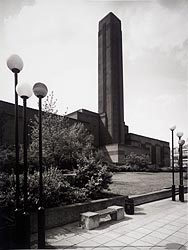|
A gallery for modern art |
Site selection |
The architecture |
The building |
The opening

Photograph of exterior of Bankside
Power Station
© Tate Archive 2003 |
Site selection

Several locations within central London were considered, either as sites on which to build or as existing buildings that had conversion potential: the South Bank; Effra (near
Vauxhall); Greenwich Reach; and Bankside Power Station were all considered.
The redundant Bankside Power Station, disused since 1981, with its striking architecture and spectacular location on the south bank of the river opposite St Paul's Cathedral,
was an exciting possibility but on first look seemed impossibly large.
Director Nicholas Serota visited the building one evening on his way home from work, and set about estimating its size by pacing the length and width of it and counting his steps.
It was approximately 500 x 200 feet, almost exactly the same square footage as the Gallery at Millbank - thus its apparently daunting scale seemed much more manageable.
The Trustees visited the building in July 1993 and were overwhelmed by its location and monumentality, and in April 1994 Bankside Power Station was formally announced as the
chosen site to house The Tate Gallery of Modern Art. |
Did you know?

Bankside is now a bustling cultural area of London, with Tate Modern and The Globe theatre popular destinations for visitors.
400 years ago it was bustling with people seeking entertainment of a rather different kind. Bankside area was known for its bawdy pursuits, with its inns, brothels, pleasure-gardens
(where such public activities as bear baiting took place) and theatres (including Shakespeare's original Globe theatre) which were not such respectable venues in those days. |
